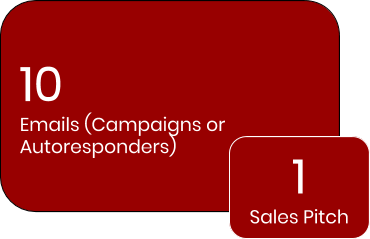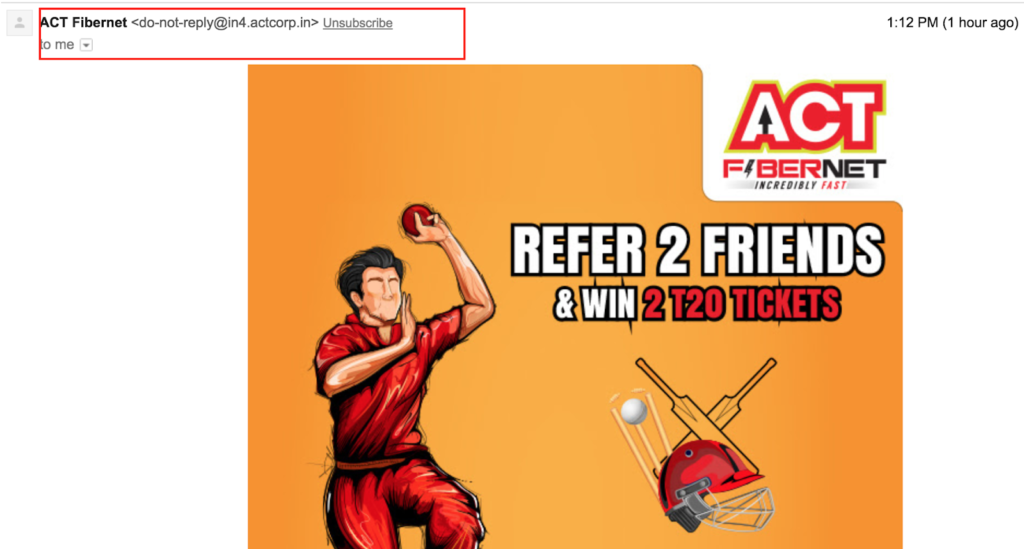You’ve heard enough about the fact that email marketing truly makes money. For every $1 spent, it gets you $44 back, on average, according to the American Marketing association.
Your email marketing stats are loud and clear.
In terms of pure return on Investment, email marketing stands unbeatable to this day, although chatbots surely look poised to give email marketing a tough competition.
Most businesses, however, approach email marketing as “something that was asked of us to do..” or “let the IT department handle it”, or “Let’s send a newsletter to all our customers” or some other variant.
A half-hearted, “let’s do it because we have to do it” or a “newsletter” approach is not the right way to do justice to a marketing channel that promises a sky-high ROI.
It’s not something that you “must” do; it’s the only thing that truly makes money so it deserves some respect, care, attention, and a high degree of seriousness.
If you’ve been doing email marketing just because you were asked to, change that mindset today.
Is Email marketing dead? No, but you might just kill it one day.
Think of your subscribers’ inboxes as sacred, personal space (unique to each of your subscribers). When you send an email, it’s an intrusion. Your job is to make that intrusion worth it.
Your intrusion into your subscriber’s Inbox is worth it if and only if:
- No amount of email marketing helps if your product or service is not worth it in the first place. Your product or service has a proven history of solving a very specific problem your subscribers have.
- Even if your product or service is terrific, selling and pitching repeatedly in your emails is a strict no-no.
- You lead your email marketing strategy with information that truly helps, inspires, educates, or teaches something new. You can follow up with an occasional pitch or two but it’s almost always subscriber-exclusive information.
With that out of the way, let’s look at how to implement an email marketing strategy that works for you as a business and is also awesome for each of your subscribers:
Use Opt-in Forms (But with Care)
Unbounce practices what it preaches and got 3000+ leads using Popups. Oli Gardner points to a few other cool and legitimate ways to use popups you might not have considered.
Brett Downes helpfully points to a few website Pop-ups done right
Should you use opt-in forms? Yes.
Can you use opt-in forms however you want? No
Lots of folks have issues with pop-ups, slide-ins, and anything that pops on a website. There’s an ongoing debate about pop-ups, of course, and there are all sorts of opinions around this single, email list generation strategy that’s so crucial for email list building.
Now, when Google comes calling out on how Pop-ups can affect SEO, there’s bound to be even more opinions about it.
Of course, all those pop-ups on your website are irritating, and have too many (or have them show up the wrong way), and you’ll have Google’s attention and fall out of favor.
No one cares if you “feel bad” about having popups or Sumo’s Welcome Mats, or Slide-ins. If you don’t have them, you won’t grow your list.
For everyone who cries foul, there are at least five businesses that grows their email list this way.
Also read: Step-by-Step Guide on How to Build an Email List
No permission? No email subscribers
Buying an email list is an absolute sin (don’t even try that). You truly suck if you still do that.
With the CAN-SPAM act, the more recent GDPR rules, and the general distaste we all have for unwelcome messages, sending out emails when you were not given the permission for it is not only utter stupidity but actually works against your business.
Your brand takes a hit, you’ll be called a scammer, you’ll be banned from sending emails again, your email service provider will freeze your account, and you’ll be left with no choice but not do email marketing ever again (and you don’t want that, do you?).
Grow your email list organically. If you have the budget, use paid advertising to grow your list.
Whatever you do, take permission first.
Also read: Build Subscriber Lists: Drop Everything Else & Do Email Marketing
Start with a customer persona
All those blog posts about customer persona weren’t written without reason: you can’t be in business for everyone.
Your marketing should be targeted to that very specific kind of customers.
As a result of choosing to target only the kind of audience that makes sense for your business, you know that your email subscribers are going to be an active, engaged, and high-interested segment of that exact same customer persona.
Chances are that there’ll be a few subscribers on your list who still don’t match your customer persona.
There’ll be outliers, misfits, and completely wrong kind of potential customers on your list (and that’s why you need an active email list cleaning, lead scoring, and active “unsubscribe” campaigns going on from time to time, and you may think of that as housekeeping).
Don’t grow a list; grow a community
Your strategy is just marketing gobbledygook if all you have is people who signed up for the sake of signing up or those who didn’t even ask to be signed up in the first place.
Beyond that, it’s all about nurturing; it’s about caring, and it’s really about making relationships. Your email marketing workflows aren’t supposed to be feeding bots; they are for real people
Using a heady mix of personalization, opening up channels to facilitate one-to-one communications, making sure you are speaking to people (and not transaction numbers).
Caring for your subscribers goes a long way to make sure you don’t just have a list (because that doesn’t mean a thing anymore) but you have an active community of evangelists for your business.
People will still unsubscribe, but it’s alright.
Also read:
11 Email Marketing Rules You Shouldn’t ever Miss
Profitable Email Marketing: Inbox is Boring; Aim for The Heart
11 B2B Email Marketing Examples You’d Fall in Love With
One Pitch for 10 Emails
If every single email in your autoresponder sequence is going to be a blatant pitch, you’ll lose more subscribers than you’ll ever gain.
It’s as simple as that. There’s no need to even point to some research statistic to prove it.
The issue with email marketing is that there’s “marketing” in there, and what that automatically makes people believe is that you can “promote” until your email marketing system can possibly crash.
That’s a bad idea, and it’s because no one likes being sold to.
Follow a framework for pitching your products, selling or services or having people to buy something off of your ecommerce store (or In-store).

A healthy ratio to pitch vs sending out valuable information is around 10:1.
This means that for every 10 emails you send out to your subscribers, only one email will have a direct pitch or a soft pitch to make your subscribers buy something from you.
Email Lists are Not One-Sided Love
Most businesses send “one-sided email messages”. Like you send an email but there’s no way for your subscribers to talk back to you.
Worse still, some email services default you to “no reply” or send out “do not reply” right there, in the header.
Don’t do this, please.
Few email marketing service providers such as Drip and MailChimp allow you to open “conversations” with your subscribers.
By making you sure that leave a small note in every email you said which goes something like:
“Have questions. Reply to this email and we’ll talk”
“Need to ask something? Please feel free to hit reply. Let’s talk”

How are you building, nurturing, and caring for your email lists? Tell me about it.

